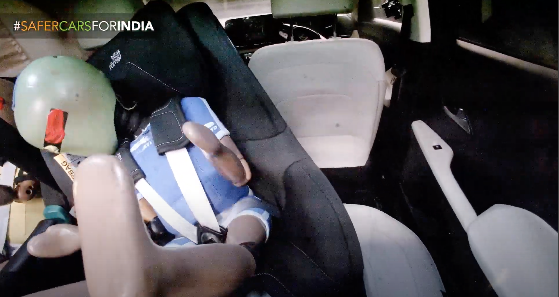The Stars Align for Hyundai's Latest Verna
- Gobar NCRAP
- Oct 3, 2023
- 4 min read
Updated: Oct 6, 2023

Global New Car Assessment Programme (Global NCAP), the UK-based consumer-testing organisation who have been known to issue crashworthiness ratings for new passenger vehicles sold in developing economies, have announced the latest set of results for their #SaferCarsForIndia project.
Their latest release sees Hyundai's new Verna midsize sedan score top marks, with five-star ratings for adult and child occupant protection - matching rivals from Volkswagen and Škoda tested earlier in the year.
The Verna is fitted as standard with electronic stability control, six airbags (2 frontal airbags, 2 side body-protecting airbags and 2 head-protecting curtains), three-point safety belts in all seating positions, i-Size compatible rear seats and reminders for the front and rear safety belts.
Global NCAP tested the Verna at Hyundai's request, and it was assessed against their latest assessment criteria for the 2023 model year (found on the webpage www.globalncap.org/resources).

In the offset frontal impact test, a Verna unit was driven into a deformable barrier at 64km/h, with 40% of its width overlapping with the barrier and two belted average adult male dummies in the front seats. This test intends to simulate the characteristics of a crash between two similar cars each travelling at 50km/h, with half their fronts overlapping. During the test, the driver's head made stable contact on the airbag and steering wheel displacement was negligible. Dummy readings showed a low risk of serious injury to most body regions, and a limited risk for the driver's chest and tibias. The passenger compartment held its shape well during the test; no significant displacement of the A-pillar was reported and no penalty was applied; however, inspection of the vehicle's structure after the test revealed that its roof and door sill[source] showed signs of having reached the limit of their ability to transfer forces. The passenger compartment was judged to have become unstable, so Global NCAP downrated protection of the driver's chest to 'marginal'. Intrusion of the pedals was negligible (a significant improvement over the Verna's SUV stablemate), but protection of the feet was downrated to 'adequate' because of rupture of the footwell. Although dummy readings indicated good protection of the occupants' knees, the unstable passenger compartment and ruptured footwell meant Hyundai were denied the opportunity to demonstrate that the knees of occupants of different sizes or seating positions would be protected similarly against impact with hard structures behind the fascias, so protection of the knees was downrated to 'marginal'.

In the side impact test, a 950kg mobile deformable barrier representing a small car was driven into the front passenger's door at 50km/h, with a belted average adult male dummy in the front passenger seat. Dummy readings indicated a low risk of serious injury to the driver's head, abdomen and pelvis, and readings of rib compression indicated a limited risk of serious fracture.

In the pole side impact test, a Verna unit was driven laterally on a sled at 29km/h, into a rigid pole representing a tall, fixed object, targeted at a belted front passenger's head. Dummy numbers from the test indicated a moderate risk of serious rib fracture for the driver, and a limited risk of serious injury to his abdomen, but the curtain airbags worked well to prevent hard contact of his head with the intruding pole.
The Verna was found to comply with UN Regulation No. 127, where a series of adult and child headform impactors strike different locations on the hood, and a lower leg impactor strikes the car's bumper. The Verna's electronic stability control system was also found to pass the robotised sine-dwell steering manoeuvre in the UN's Regulation R13-H. Global NCAP awarded the Verna only one additional point for its safety belt reminders, because the system installed in the rear seats failed to comply with the organisation's performance requirements.
Hyundai recommend the following child restraints:
18 month-old child: "Britax BabySafe 3 + Flexbase 5z", rearward-facing
3 year-old child: "Britax Dualfix 3", rearward-facing
The Verna has two i-Size compatible seating positions and three-point safety belts for all seats, and was shown to safely accommodate a variety of child restraints on the market. It does not provide for the disconnection of the front passenger's airbag should the need to install a rearward-facing child restraint on that seat arise, but according to Global NCAP, it adequately warns of the danger associated with doing so. PLACING A REARWARD-FACING CHILD RESTRAINT ON A SEAT WITH AN ACTIVE AIRBAG POSES A RISK OF DEATH OR SERIOUS INJURY!
During dynamic testing, the 18 month-old and 3 year-old child dummies were placed in the child restraints recommended by Hyundai, installed rearward-facing in the Verna's i-Size compatible outboard rear seats using its ISOFIX anchorages and a foot-prop. Both child dummies were awarded full marks for dynamic testing for front and side impact, but with a catch.

Global NCAP say that during an initial side impact test, the child restraint for the 3 year-old child was found to detach from the Verna's ISOFIX anchorages. Britax were consulted, and informed Global NCAP that this was a "one-off". Global NCAP subsequently retested the Verna in a "higher energy" side impact test (details of which are not known), and confirmed normal operation of the problematic child restraint. Britax have yet to issue an official statement.
Find Global NCAP's official press release at www.globalncap.org/news.







Comments